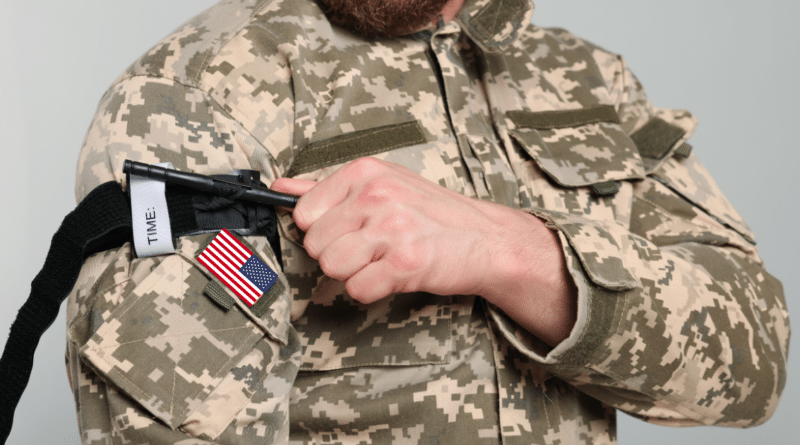Life-Saving Drills: The Importance of a Training Tourniquet
Do you have a dedicated training tourniquet? A better question would be, do you even train using a tourniquet? If you carry a concealed firearm and don’t have a tourniquet, you’re wrong.
You’re far more likely to need to use a tourniquet than you ever will be pulling out your firearm and using it (more on this topic is found in this article I wrote). But if that day ever arises when you need to use your firearm for self-defense, I want to paint a scenario out for you.
Imagine being in a situation where every second counts; a moment when using a tourniquet could mean the difference between life and death. Perhaps you feel uncertain about your ability to apply it correctly under pressure.
That concern is not only common but also incredibly human. It underscores the critical need for proper training with life-saving tools like North American Rescue tourniquets, tools with a powerful patent that can stop severe bleeding and potentially save lives if used correctly by applying circumferential pressure to the extremity so that bleeding will cease.
In light of this scenario, I decided to dig deeper into how we can conquer these fears by emphasizing the value of practicing with a training tourniquet and ensuring you’re getting your tourniquet adequately tightened to stop the bleed (pretend when practicing). Training sessions equip us for real-life emergencies, boosting our skills and confidence without jeopardizing essential equipment reserved for actual crisis scenarios and emergencies.
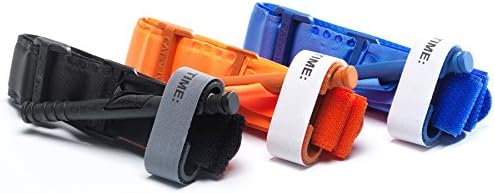
In this article, we will dive deeper and share insights on why dedicating time to practice with a training tourniquet isn’t just advantageous; it’s crucial for anyone who wants to be ready in moments that challenge our resolve and require immediate action.
Continue reading to learn how integrating simple drills into your routine using a training tourniquet can significantly impact your overall preparedness and ability to save life.
Disclaimer: It should be noted that while I have taken medical and trauma medical classes, I am not a medic, EMT, or professional in that field. I am simply a well-trained civilian who wants to put out valuable information that good people (like you) can learn from.
Table of contents
Key Takeaways
- Training with a dedicated tourniquet improves your skills and builds muscle memory for quick, accurate application in emergencies.
- A training tourniquet, often blue, helps distinguish it from actual emergency devices, ensuring real lifesaving gear remains ready and intact.
- Practicing regularly with a training tourniquet boosts confidence and effectiveness in applying it during high-pressure situations to stop severe bleeding fast.
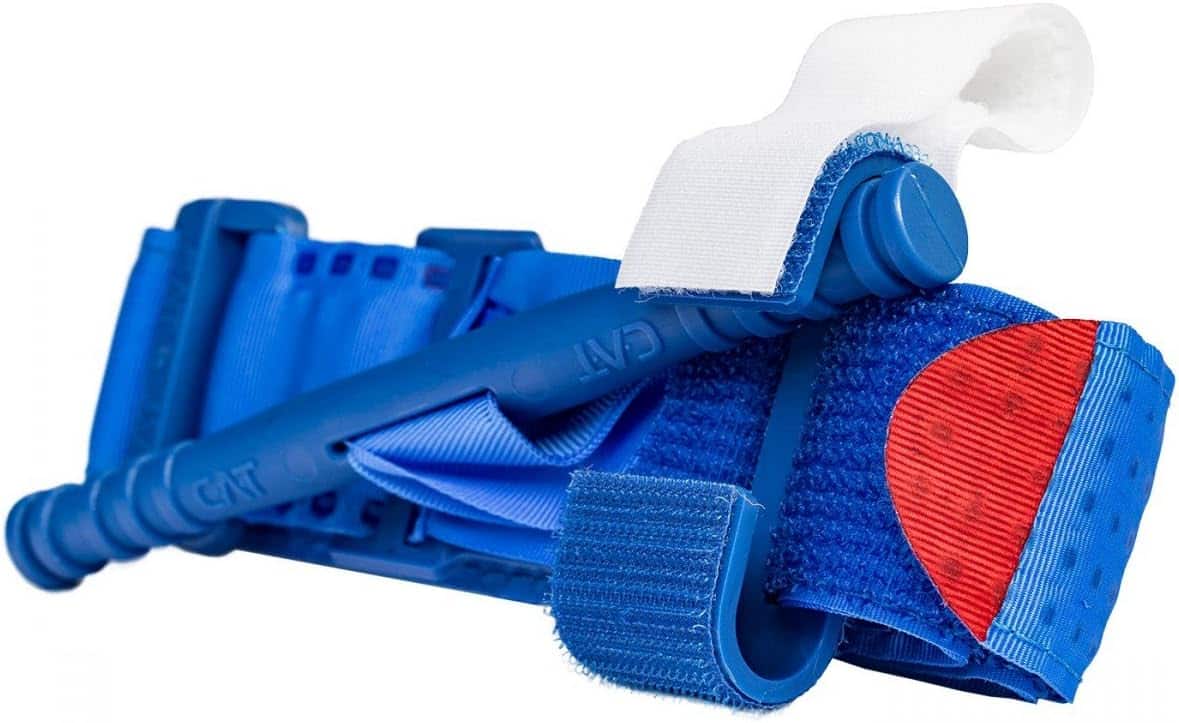
Understanding the Need for a Training Tourniquet
Everyone should understand the need for a training tourniquet to improve hands-on skills and muscle memory. Using a dedicated training tourniquet is crucial in preparing for life-or-death situations and maintaining the integrity of lifesaving tourniquets.
Regardless of the type of tourniquet you carry (CAT, SOF-T, ETQ, RATS, or SWAT-T), you should have a dedicated training tourniquet that matches what you carry or have in your kit.
Depending on which of the following you carry, consider grabbing the training tourniquet version below:
1. Importance of hands-on training with a training tourniquet
Hands-on training with a tourniquet is key for first responders to effectively save lives. Through direct stop the bleed training, I learned to swiftly apply a combat application tourniquet (C-A-T) in high-pressure situations. If you need to apply a tourniquet, things are bad, and in order to stop the bleeding, you need to completely occlude the limb. Application time is of the utmost importance at this stage.
This type of training turned my theoretical knowledge from trauma medical classes (like the one from Iron Forge Consulting Group) into concrete skills. Such training provided me the ability to build up my confidence and taught me the importance of teamwork and clear communication during emergencies.
Using a dedicated training tourniquet colored blue makes it easy to identify it as a tool for learning rather than an emergency device. This distinction with my practice tourniquet ensures that I’m always prepared with the right equipment during actual life-or-death scenarios. Getting in the reps with a practice tourniquet allow for extremely fast application when a scenario calls for such a device (this can be a car wreck, gunshot wound, a large cut, etc.).
If you only have the common black tourniquets, pull one and mark it with a paint marker to ensure you know that’s your dedicated training tourniquet that you are to only use during practice and training to ensure it doesn’t go back into the mix of tourniquets you plan on using in an emergency.
By practicing with this specific device, not only do I (and you) reinforce crucial muscle memory but also prevent wear on lifesaving tourniquets meant for real incidents. The ability to provide extremely fast application and effective in occluding blood flow to save a life. And if you don’t practice, you risk failing under stress or where fine motor skills are completely absent.
2. Different from tourniquets used in emergencies
Training tourniquets are not the same as those we use in real emergencies. I make sure to keep them separate. Emergency tourniquets, like the combat application tourniquet or CAT, need to be ready and in perfect condition if a life-threatening situation happens. I don’t want to risk using a tourniquet that I’ve been training with, which could have potentially been damaged through multiple applications during training.
I like the CAT tourniquet because it is a true one-handed tourniquet proven to be effective — especially when compared to something like the SWAT-T. And that’s not a knock at the SWAT-T, but it’s a fact that it’s more difficult to put it on yourself as compared to putting it on others. Just a side note: if you have a dog or kids, the SWAT-T is extremely effective on them.
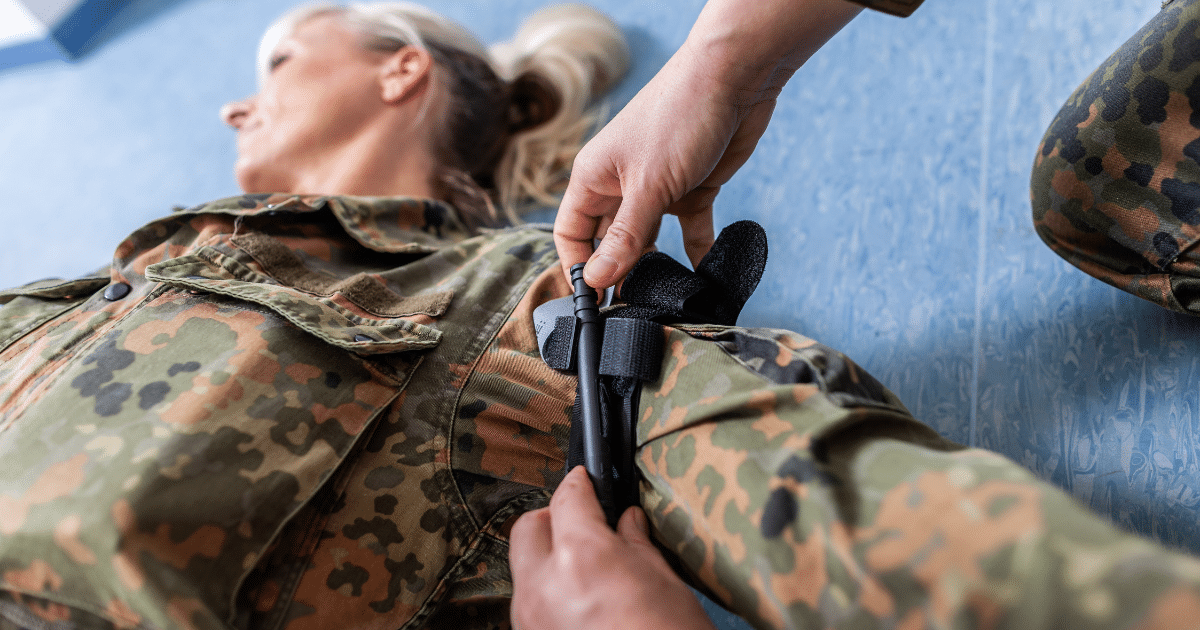
This is where training with a dedicated training tourniquet becomes crucial. It helps me practice without wearing out the vital gear meant for actual crises.
Using a distinctive blue training version, such as the Gen 7 CAT Tourniquet – Blue, allows for clear identification. This means there’s no confusion between my training gear and the equipment reserved for emergencies and the blue color is a means to distinguish training devices from ones to be used to save lives.
By practicing with something like a blue C-A-T tourniquet model with a visual means to distinguish training that functions just like the real thing but is designed specifically for repeated use, I build muscle memory and speed. And this doesn’t compromise my lifesaving devices’ integrity or effectiveness.
Again, if you don’t want to purchase a blue training tourniquet, I would recommend purchasing one dedicated for training or pulling one from your tourniquet stash you should have built up over time for all your med kits or range bag. However, there is a need for tourniquet application practice regardless of the direction you go.
3. Improving skills and muscle memory
I practice with a training tourniquet to make my skills sharp and ready. Each drill helps me build muscle memory, making application quick and accurate in high-stress situations. This type of rehearsal is vital for law enforcement officers, paramedics, and the prepared citizen (like myself), where saving lives often depends on speed and precision.
Using a training tourniquet that’s colored blue allows me to distinguish it from real ones meant for emergencies. It’s designed for repeated use without wear, ensuring I can train as often as needed. If it ever breaks or wears down, I simply replace it with a new one and can continue training.
This hands-on practice is crucial for mastering the technique, especially when learning how to apply effective circumferential pressure to stop bleeding fast.
The Purpose of a Training Tourniquet
A training tourniquet serves the purpose of providing safe and realistic hands-on training for effectively applying a tourniquet in emergencies. It also helps develop proficiency and speed in tourniquet application while preventing damage to lifesaving equipment.
1. Safe and realistic training
Training tourniquets are crucial for safe and realistic training in life-saving scenarios. They help build proficiency, prevent unnecessary damage to your emergency tourniquet, and ensure you’re well-prepared for real emergencies.
It’s essential to practice with both hands, but advanced training may focus on single-handed application to enhance your skills effectively. Professional-level tips and techniques provide the advanced training necessary to prepare responders fully for real-life incidents.
2. Developing proficiency and speed
To develop proficiency and speed in tourniquet application, hands-on training should emphasize the importance of quick and accurate placement to stop bleeding effectively. It is crucial to practice applying the tourniquet swiftly and efficiently since proper technique can significantly impact survival rates.
Using both hands during drills helps build basic skills before advancing to more complex techniques, allowing for faster application when every second counts in a life-threatening situation.
Efficient tourniquet training has been shown to yield statistically significant results in terms of placement site and time, making it vital for self-defense and firearms enthusiasts to master this life-saving skill.
3. Preventing damage to lifesaving tourniquets
Proper training with a dedicated tourniquet helps prevent damage to life-saving tourniquets. This ensures that when an emergency arises, the tourniquet is in good condition and ready for effective use.
By using a training tourniquet specifically designed for practice, the risk of wear and tear on actual lifesaving tourniquets is minimized, guaranteeing their integrity in critical situations.
Investing time in proper training can help avoid unnecessary use of tourniquets and ensure they are applied accurately in emergency situations. It reinforces the significance of accurate assessment before applying a tourniquet, ultimately contributing to better trauma care practices.
Reasons to Invest in a Dedicated Training Tourniquet
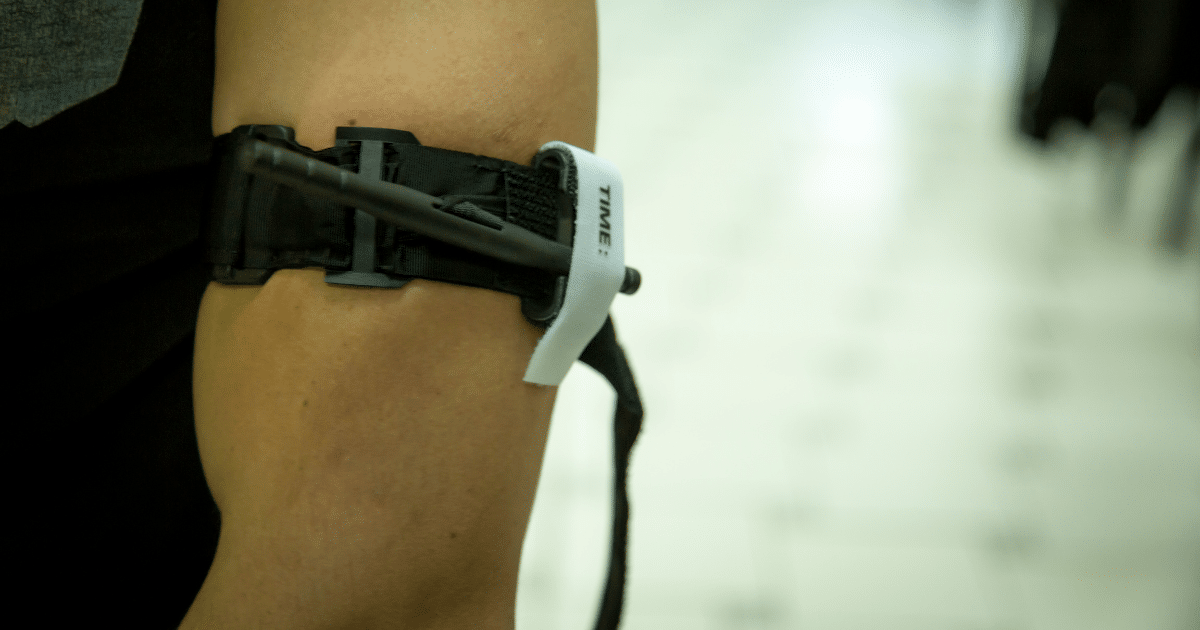
Investing in a dedicated training tourniquet prepares you for life-or-death situations and ensures effective use in emergencies. The below dives deeper into the importance of hands-on training and proper preparation for medical professionals.
1. Preparing for life-or-death situations
Preparing for life-or-death situations is crucial in self-defense and firearms training. Not only is this important as something could happen to you at the range when training, but also in an actual gunfight where you’re protecting your life.
Tourniquet training is essential as it prepares us for critical moments where applying a tourniquet could mean the difference between life and death. A devastating gunshot wound or cut could kill you quickly. And when those seconds count, you don’t want to be fumbling around with a tourniquet or wondering what to do.
The goal of such training programs is to make these lifesaving skills as prevalent as CPR, reinforcing the importance of applying a tourniquet during drills or exercises and ensuring that everyone can act swiftly and effectively when faced with an emergency.
Effective tourniquet training underpins our ability to respond decisively, potentially saving lives in high-pressure situations.
2. Proper training for medical professionals
Medical professionals require proper training in tourniquet use to effectively save lives in trauma care. Evidence supports the use of tourniquets by trained wilderness first-aid providers, highlighting the critical importance of acquiring proficiency in this life-saving skill.

Investing in dedicated tourniquet training enables medical professionals to become adept at applying them during life-or-death situations, ensuring effective and timely interventions when faced with exsanguinating hemorrhage (death due to blood loss).
3. Ensuring effective use in emergencies
It is essential to have tourniquet training programs to ensure effective use in emergencies. The application of tourniquets needs to be taught as a fundamental technique, reinforcing its importance through drills or exercises, which can significantly impact the outcome of life-threatening situations.
Designating a tourniquet for training purposes only is crucial to prevent mistaken use in real emergencies and maintain its integrity.
4. Maintaining the integrity of lifesaving tourniquets
Using a dedicated training tourniquet ensures that real emergency tourniquets remain intact. Proper training with the right tools guarantees their effectiveness during critical moments.
The placement and application of these lifesaving devices are pivotal in saving lives in dire situations, emphasizing the significance of precise tourniquet use.
Having a Dedicated CAT Training Tourniquet (or Any Version) is Essential for Practice
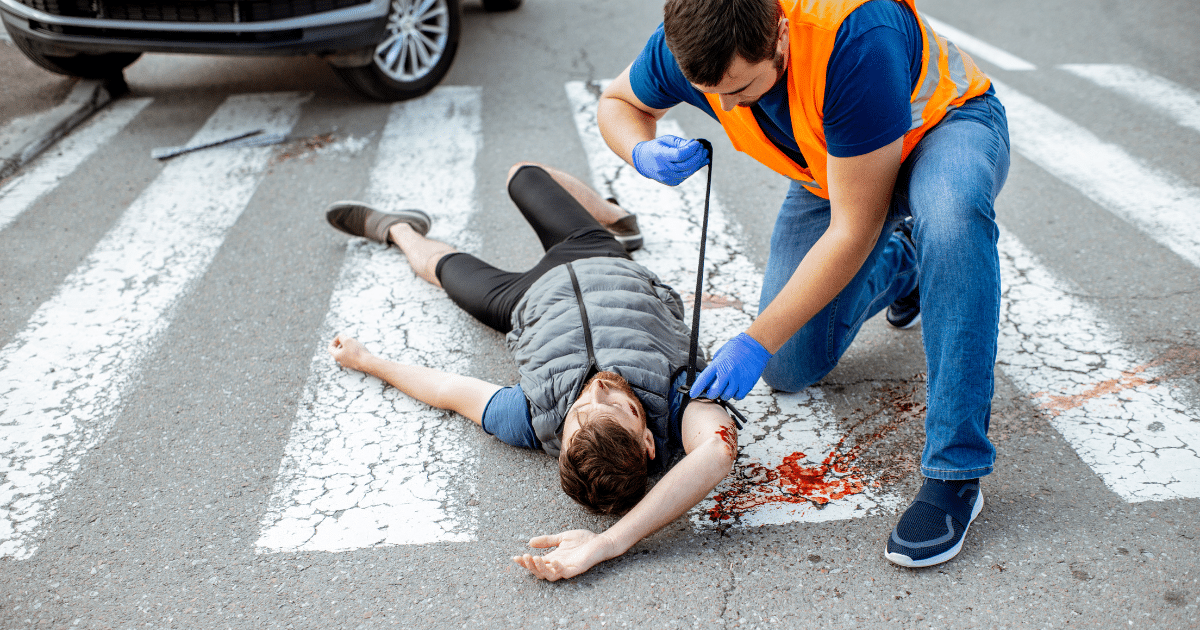
To put a nice bow on this article, it’s safe to say that training tourniquets are crucial for honing life-saving skills. They provide hands-on practice and prepare medical personnel for emergencies. Proper tourniquet training is key to swiftly and effectively stopping severe bleeding, ultimately saving lives.
Investing in dedicated training tourniquets ensures readiness and proficiency in critical situations without compromising the tourniquets you use during an emergency situation. Rapid deployment of these tools can make a significant difference when every second counts.
If you’re looking for a dedicated training tourniquet, below are three great options to consider:
As a side note to close out this article, if you want to support our website and are in need of any tactical gear (or any product for that matter), anything you purchase using our links below will provide us with a small commission. We don’t charge for our free content and our goal is to keep it that way. We don’t have a Patreon account to put things behind a paywall, nor do we sell pics of our feet on OnlyFans. If you choose to use the links below and make a purchase (at no additional cost to you), we greatly appreciate your support as it helps us continue to publish free content (like this article) on our website:
- Optics Planet (use code SAS5 at checkout for 5% off)
- Amazon
And if you have a product you would like us to check out and potentially review, please contact us and let’s discuss.
Training Tourniquet FAQs
A training tourniquet is a device designed for practice. It helps people learn how to stop bleeding by applying pressure around an extremity without causing harm.
The C-A-T® tourniquet is colored blue to make it easy to tell apart from real ones. This way, during drills, everyone knows it’s for learning and not for actual use.
The windlass system uses a rod that twists to tighten the band around an arm or leg. This stops blood flow effectively when done right.
Yes! By practicing with a training device like the combat application tourniquet trainer, both instructors and trainees get hands-on experience. This makes them ready to act quickly in real-life emergencies.
The fully functioning Gen 7 C-A-T® has features like reinforced windlass and unique dual securing systems that avoid screws or clips, making it reliable under stress.
Yes, these devices have places where you can write down important details, like the time of application during practice sessions.
Training Tourniquet Resources
https://www.mayoclinic.org/medical-professionals/trauma/news/the-crucial-role-of-tourniquets-in-trauma-care/mac-20531726
https://cprcertificationnow.com/blogs/mycpr-now-blog/tourniquets-understanding-their-purpose-and-application
https://www.ncbi.nlm.nih.gov/pmc/articles/PMC9914968/
https://www.personaldefensenetwork.com/post/designated-training-tourniquets/
https://journals.sagepub.com/doi/10.1177/2165079920930730
https://lifesafety.org/articles/the-importance-of-hands-on-training-in-emt-classes
https://www.ncbi.nlm.nih.gov/pmc/articles/PMC9915853/
https://www.mayoclinic.org/medical-professionals/trauma/news/the-crucial-role-of-tourniquets-in-trauma-care/mac-20531726
https://study.com/academy/lesson/tourniquets-definition-history.html
https://www.researchgate.net/publication/6406793_Extended_16-Hour_Tourniquet_Application_After_Combat_Wounds_A_Case_Report_and_Review_of_the_Current_Literature
https://www.researchgate.net/publication/51841342_The_Military_Emergency_Tourniquet_Program%27s_Lessons_Learned_With_Devices_and_Designs
https://www.ncbi.nlm.nih.gov/pmc/articles/PMC10662576/
https://www.ncbi.nlm.nih.gov/pmc/articles/PMC2660095/
https://study.com/academy/lesson/tourniquets-definition-history.html
Tourniquet training that stops bleeding and saves lives
https://www.jeffersonhealth.org/your-health/living-well/how-to-save-a-life-with-a-tourniquet
https://www.usconcealedcarry.com/blog/the-tourniquet-an-important-everyday-carry-item/
https://apps.dtic.mil/sti/tr/pdf/ADA614535.pdf


*Disclosure: This article may contain affiliate links or ads, which means we earn a small commission at no extra cost to you if you make a purchase through these links. These commissions help support the operation and maintenance of our website, allowing us to continue producing free valuable content. Your support is genuinely appreciated, whether you choose to use our links or not. Thank you for being a part of our community and enjoying our content.
PLEASE CONSIDER SHARING THIS ON YOUR SOCIAL MEDIA TO HELP OTHERS LEARN MORE ABOUT THIS TOPIC. SIMPLY CLICK BELOW!

